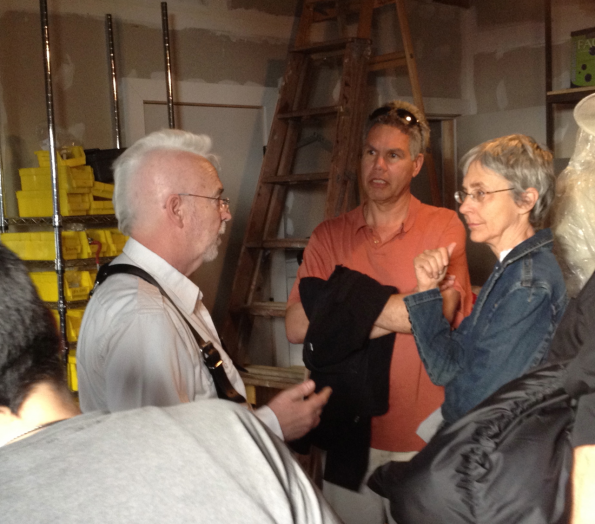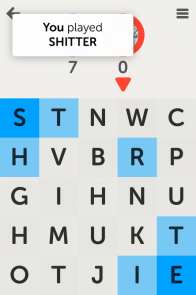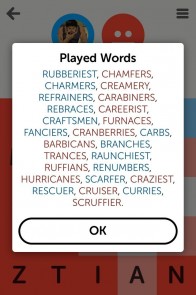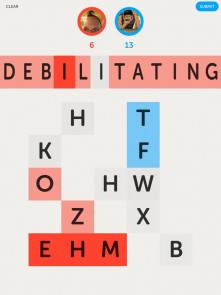I’ve been playing Rock Band in whatever its current incarnation is pretty much every weekend since the first iteration of the series came out. At first, I liked playing fake plastic guitars and was curious about drums (and, to a lesser extent, singing), and I enjoyed having people with good musical taste select songs for me to go through. (I only regularly listened to pop music for something like four years of my life, so I have a lot of gaps to fill!) That might have gotten stale eventually, but then the Beatles version came along with songs I love (and adding vocal harmonies, which were surprisingly interesting), and a year later Rock Band 3 allowed you to play on a real keyboard and a real guitar. I bought the Fender Squier Rock Band 3 guitar as soon as it came out (a few months after the game was released, but that’s okay, the delay gave me time to get keyboards out of the way first), and I’ve put in a few hours with that every weekend since March 2011.
That turned out to be an incredibly enriching experience. I actually always found Rock Band to be an informative guide to different ways to investigate songs, but its pro guitar mode is a much deeper dive than any of its other modes are. And it really did help me learn guitar: the game didn’t turn me into a good guitar player, or even a decent one, but I could find my around a fingerboard well enough for most songs, I can play standard chords (including barre chords) fairly reliably now.
Rock Band 3 isn’t the only game out there that’s trying to teach you how to play on a real guitar, though. In particular, Rocksmith appeared towards the end of 2011, a game which is focused exclusively on playing on a real guitar: its major selling point is that it comes with a cable that does DSP magic allowing you to plug any electric guitar into it, instead of restricting you to one specific (and musically inferior) model. If that could work, that’s great; initial response was mixed (in particular complaining a lot about audio lag), but some people were positive. Still, reading the initial responses, I figured I’d stick with Rock Band 3: it seemed that nobody was on the fence, people were generally strongly against one game or the other. And given that I liked Rock Band 3 and was getting a lot out of it (in ways that many other people clearly weren’t), it seemed likely that it was a better fit for me. (Kirk’s review swayed me, too.)
Still, I hadn’t mentally written off Rocksmith entirely; and, a year later, I started hearing more positive comments about it. (I imagine the recent PC release helped broaden its audience.) So when Rampant Coyote wrote a blog post discussing the two games, saying positive things about both, I looked at the price and decided I could give Rocksmith a try: I’d probably end up too annoyed by the lag and the design choices to stick with it very long, but the potential upside was high. And I’m curious about games and learning and music anyways, so I should explore their intersection.
That turned out to be the right choice. I’m trying to write this blog post in a way that isn’t negative towards Rock Band 3, because I have a huge amount of respect and appreciation for that game: I’m very glad I spent as much time with it as I did, I enjoyed the experience and learned a lot. Heck, for all I know I would have found Rocksmith frustrating to play at the beginning if Rock Band 3 hadn’t prepped me in advance: there’s a lot of basic skills that Rock Band 3 taught me, and I simply have no idea what Rocksmith is like for people without those basic skills. And when I was feeling particularly lost on the guitar fingerboard, I very much appreciated the Rock Band 3 Squier’s ability to tell me what fret I was holding down before I strummed it, it meant that I didn’t use looking at the guitar as a crutch as much as I otherwise would have had to.
But, having said that, my Rocksmith experience is starting to make me wonder about Rock Band 3, and in particular about Harmonix’s design goals for the game. One of my favorite talks from the first GDC I attended was one that Dan Teasdale gave about Harmonix’s design philosophy: for every game, they have One Question that they’re trying to keep in mind. For the original Guitar Hero, it was “Does this rock?”, for the original Rock Band, it was “Is this an authentic band experience?”. For Rock Band 3, Harmonix kept the same question of “Is this an authentic band experience?”, but decided to emphasize the “authentic” part: going in the direction of real drums (cymbals, twin kick pedals), real keyboards (an instrument they’d left out entirely in earlier iterations), and, most ambitiously, real guitars.
In hindsight, this question was perhaps too flexible. You can justify a lot in terms of authenticity: get rid of the fake instruments entirely, make people play for real, have every sound come from players’ actions! If you don’t want to go that far, you can say that the goal is just to have people feel like they’re playing in a band without making them too uncomfortable; but once you allow that flexibility, you can land anywhere in the design space from the original Rock Band to Rock Band 3 to beyond. And once you have such a broad design space, I don’t see how the One Question helps you make choices any more.
I have no idea if the folks at Rocksmith use a similar One Question approach, but I also have no difficulty in imagining a question that would work for them: “Does this help you learn how to play guitar?” That gives a much more focused answer: everything in the game is about having the player sit down with a guitar, trying to get the sounds that come out of the guitar sound more and more like the sounds that real rock guitarists produce.
Now, that difference in questions doesn’t make Rocksmith a better game than Rock Band 3; but it does mean that Rocksmith is, to my mind, a significantly more coherent game than Rock Band 3. In retrospect, maybe Bohemian Rhapsody was an even better choice for Rock Band 3‘s signature song than I realized at the time: the game’s glorious multiplicity means that there are always new, significantly different experiences to be found if you’re looking for them. (As I was stopping using Rock Band 3 to learn how to play guitar, I was also starting to sing more with the game!) But Rocksmith‘s focus is very powerful indeed: as soon as I came home today, I picked up the guitar and turned on the Xbox so I could practice, and I practiced more while dinner was cooking, and I’m already thinking ahead to whether I’ll have time to do the same thing tomorrow.
At its core, Rock Band 3 remains a video game in a rather traditional sense, even when playing in pro guitar mode: it’s about pressing appropriate controls at appropriate times to get the desired effect on your environment. Hold down these buttons and strum, now shift to these buttons and strum, and continue. For a game, it’s quite prescriptive about this: you have a bit of choice on how to use the controls (whether or not to strum on a hammer-on, when to activate overdrive, etc.), but with the exception of vocals, it’s fundamentally a game about pressing buttons the way it tells you to.
This continues with pro guitar mode. The difference there is that you have over a hundred buttons to press instead of five plus a scroll bar; and that really is a huge difference, it opens up a rich world of associations and linkages to you. I come from a piano background; to a first approximation, a piano is a collection of 88 buttons, and while that first approximation leaves out a lot, it also includes a lot.
And, for better or for worse, Harmonix made certain choices that keep it anchored within that game space of pressing buttons, that maintained a distance between you and the music. Even before I started playing pro guitar mode, I was frustrated that the game didn’t offer a mode where I could hear my mistakes when playing pro keys; I asked Harmonix about this after a GDC talk, and I was told that they felt that preserving the illusion of sounding great was so important that they wouldn’t allow modes that broke through that illusion.
With pro guitar, unlike with pro keys, there’s an easy workaround to that problem: unmute your guitar and plug it into an amp while you’re playing. Unfortunately, here you run into another problem: if you unmute the guitar strings, then the game will think you’re strumming when you’re not. You’ll get a bad score, which I can take or leave; but the game will play a jarring “wrong note” sound and stop playing the regular track for a bit, both of which are significantly more annoying. Miranda takes violin lessons, and a fair amount of that time is spent with her and her teacher playing a piece together; you can do that in Rock Band 3, but it’s like having a teacher who will stop playing and make a screeching sound with his bow every time you make a mistake, and who will randomly do that occasionally when you don’t make a mistake. This is neither a pleasant nor a didactically effective choice.
It is, however, a choice that is true to Rock Band‘s video game heritage. At its core, the game retains a strong focus on racking up points, and judging you by that criterion: and it’s as afraid of giving you points you don’t deserve as it is of taking away points that you do deserve. It wasn’t until I played Rocksmith that I realized how jarring that is: Rocksmith never penalizes you for playing extra notes, so not only does the question of false strums not arise, you can even try to listen and figure out the full versions of sections of the song that it’s only giving to you in a reduced difficulty. Rock Band 3‘s overdrive mode is another example of inappropriate game trappings that Rocksmith leaves out: if I’m focused on learning guitar, then the last thing I want to think about is what my streak multiplier is and whether I’m likely to be able to retain that and, if so, to lift the head of the guitar even if that interferes with my playing.
One of Roger‘s aphorisms is that “learning is always learning to play”. And one of the tenets of the practomimetic learning approach that he and his associates try to follow is that, in a well-designed game for learning, there is no distinction between evaluation and your didactic goals: playing the game well should be exactly the same as doing whatever you’re trying to learn well.
To my mind, Rocksmith does this extraordinarily well. As I mentioned above, it starts out by getting this right in a subtle way: it tries to avoid situations where the game punishes you for playing well musically. Guitarists might actually quibble with me on this one, because one way in which rock guitar differs from my classical piano background is the flexibility in exactly which notes you play to get a given chord; Rocksmith gives you a lot of wiggle room, but it does ultimately expect you to be playing from a given score. With that caveat aside, though: you can throw in extra notes, you can experiment with different techniques to silence strings that you don’t want to have sustain, and the game doesn’t care, it will accept what you throw at it. (Also, as far as I can tell, its strum detection leans fairly strongly towards claiming that you’ve strummed if there’s any doubt.)
It also has a significantly richer domain model than Rock Band 3 does. Rock Band 3 doesn’t model string bending at all (and in fact the electronics of its guitar make it actively hostile towards string bending); several songs in that game made a lot more sense to me in places when I realized that what I thought sounded like a HOPO grace note that somehow wasn’t modeled in the game was actually a string bend. Rocksmith‘s treatment of string muting is also much better than Rock Band 3‘s: the latter game entirely ignores the melodic aspect of string muting (making Take On Me very frustrating in the middle of the song), and it fails to distinguish between palm muting and muting coming from chord changes. (To be sure, Rocksmith isn’t perfect here: palm muted notes are one area where the game sometimes incorrectly claims that you have missed a note.)
One of Kirk’s points in his aforementioned review is that “Teaching music is a fundamentally human act, and it can only be properly done with soul and love.” When I started playing Rock Band 3, I was thinking I might start taking guitar lessons from an actual human being at some point; I still might do that, but I haven’t yet.
And there are ways in which having a person to guide me would be helpful, no question about it. My first couple of sessions with Rocksmith had moments of frustration that I would have gotten past much more quickly with a human teacher: sometimes notes weren’t registering when I was playing the correct fret, and I wasn’t sure why, and figuring out how much to bend strings took me several iterations. I’ve gotten over both of those problems (the former was caused by me pressing too hard on the strings, making them go sharp—stiffer strings helped a lot with that—while the latter was helped through a combination of me learning what to listen to and getting a guitar that isn’t actively hostile to bending strings), but I would have gotten over them much faster with a human helping me to give me pointers.
And I’m sure there are other ways in which having a human teach me would be a huge help: focusing more on musicality rather than on simply getting the notes right, in particular. Having said that, working with a game has active benefits, and benefits that go beyond the obvious ones of constant availability of instruction and cost savings. Because I really like having fifty-odd songs to work through, seeing a different set of songs every session and having more and more notes added to the song in each playthrough: I liked that in Rock Band 3, I like that in Rocksmith, and I’ve never had a human music teacher just dump me into a lake full of music like that. (Miranda had probably been taking violin lessons for about four years before she’d been asked to play fifty different songs!) Not that the traditional approach of having you focus on really learning a song isn’t a good one; but Rocksmith has that too, because once you get good enough on a song, you’ll get dumped into Master Mode where you have to play the song from memory.
Of course, Kirk’s point isn’t just about the details of human interactions in a teaching context: it’s about soul more broadly, something that he says the Rock Band series captures better than Rocksmith. And I agree with him about that: returning to Rock Band‘s One Question, you can tell that Harmonix is focusing on the “authentic band experience” as a whole. So yeah, there’s a lot less soul in Rocksmith‘s opening with its focus on guitar closeups. To me, though, that doesn’t point at a flaw in Rocksmith so much as a difference (though, to be honest, that intro could be improved): Rocksmith is focused on learning guitar, not on feeling like you’re in a band. And putting instruments front and center fits within that in a way that Rock Band‘s intro wouldn’t.
And the benefits of this focus on instruments are a lot more concrete to me than it would have been even a month ago. I always knew that the Rock Band 3 Squier was a bad instrument, and was planning to move up to something better once I was sure I’d outgrown it and would appreciate the difference in a better instrument. But I never got around to doing that, and never really felt the lack, for over a year and a half.
I started playing Rocksmith in late October; within a couple of weeks, I could see that my guitar wasn’t responding the way I wanted it to. So, at the end of November, I got it set up properly; that helped, but part of the way in which it helped was to bring clarity to ways in which I wanted a better instrument. By the middle of December, I was actively planning on getting a better guitar, trying out friends’ instruments to see what in them I liked more and what I liked less. The first weekend in January, I went shopping, found a great deal on a truly lovely instrument; as soon as I brought it home and started playing it, I had absolutely no doubt that I’d made the right choice, and I’ve barely put it down since then.
So yeah, Rocksmith is focused on guitars, while Rock Band is focused on being in a band. But there’s soul in Rocksmith‘s approach, you just have to dig a bit deeper to find it: it’s helped me forge a bond with an instrument that I hadn’t had before.
And, actually, I think Rocksmith will ultimately end up being better for me on the band front, too. I like playing along with the game quite a bit, and I have no qualms about treating it as an essentially solo experience. (I like playing chamber music with friends on the piano, but I spend a lot more time there playing solo music as well, and that’s great.) But Rocksmith, unlike Rock Band 3, does expose multiple different guitar parts for every song, instead of trying to combine them into one; aside from being didactically interesting (among other things because I realize how repetitive some of those parts are!), this also actively welcomes multiple guitarists playing together.
And that isn’t just an abstract benefit for me. One of my coworkers started playing Rocksmith over the holiday break, and I think a second one is going to dive into Rocksmith‘s bass mode; that means that my friends and I have access to a collection of songs that we can learn and play together. We’ve already come up with our initial setlist to work on learning; I’m not sure if we’ll get together this weekend or next, but I’m sure that a month from now we will have played together, probably more than once.
Neither of these games is close to perfect; but both of them have enriched my life hugely. And I love the direction in which they’re pointing: towards a world full of music at your fingertips, a world where learning is learning to play (in the double sense of playing music and playing games), a world where there’s a helping hand always available to guide you from listening to pieces to your first stumblings playing them to increased confidence. And a helping hand that doesn’t try to confine you to its realm: the direction that it’s leading you is towards a wide-open world of music, and if you take off and start running through that world on your own, it’s happy to let go, to send you off with a wave and the best of wishes.


























 Posts
Posts